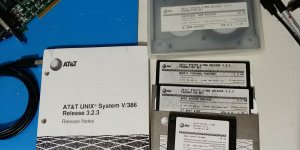History behind the disk images of AT&T UNIX System V Release 4 Version 2.1 for 386?
I'm curious as to the origins of the AT&T UNIX System V Release 4 Version 2.1 binaries and source code that are floating around the internet. From what I've read, all System V UNIX releases were sold by vendors and AT&T never released their own version. Is this incorrect? My understanding was that to obtain a UNIX OS in the 80s and early 90s, one would need to get a compiled version from a vendor, such as HP-UX, AIX, Solaris/SunOS, etc. These companies would license SVR4 and then release their own versions--usually on their own hardware.
Given this, I wanted to find an early version of UNIX that ran on x86 and had little modifications done to it by the vendor. This lead me to searching for Dell UNIX, which I've read had very little, if any, changes made by Dell and was used as the reference UNIX implementation by Intel. However, much to my surprise during this search, I found YouTube videos of AT&T UNIX System V Release 4 Version 2.1 OS running on a white box 386. From the video, there was no vendor branding at all nor any copyright messages of another vendor, so it would be appear to be as pure a SysV R4 system as one can get. The source and RAW floppy images are even available from abandonware archives.
Where did this version come from and what is the history behind it? When did it become available? Was it the version sent to vendors prior to them taking it for their customizations? An internal AT&T build? Was it intended for any particular PC or set of PCs? I've seen no mention of this release in any wikis nor in magazine articles, so I'm curious where this release came from and when it came out.
I'm curious as to the origins of the AT&T UNIX System V Release 4 Version 2.1 binaries and source code that are floating around the internet. From what I've read, all System V UNIX releases were sold by vendors and AT&T never released their own version. Is this incorrect? My understanding was that to obtain a UNIX OS in the 80s and early 90s, one would need to get a compiled version from a vendor, such as HP-UX, AIX, Solaris/SunOS, etc. These companies would license SVR4 and then release their own versions--usually on their own hardware.
Given this, I wanted to find an early version of UNIX that ran on x86 and had little modifications done to it by the vendor. This lead me to searching for Dell UNIX, which I've read had very little, if any, changes made by Dell and was used as the reference UNIX implementation by Intel. However, much to my surprise during this search, I found YouTube videos of AT&T UNIX System V Release 4 Version 2.1 OS running on a white box 386. From the video, there was no vendor branding at all nor any copyright messages of another vendor, so it would be appear to be as pure a SysV R4 system as one can get. The source and RAW floppy images are even available from abandonware archives.
Where did this version come from and what is the history behind it? When did it become available? Was it the version sent to vendors prior to them taking it for their customizations? An internal AT&T build? Was it intended for any particular PC or set of PCs? I've seen no mention of this release in any wikis nor in magazine articles, so I'm curious where this release came from and when it came out.

